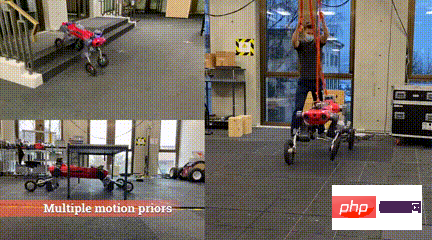
Remember that robot racing with Tesla?

This is a four-legged wheel-legged robot with the same name as the company developed by a spin-off company from the Swiss Federal Institute of Technology in Zurich—— Swiss-Mile, formerly known as ANYmal quadruped robot.

Less than half a year since it raced with Tesla, it has achieved another major upgrade.



##Faced with obstacles:





For general imitation learning, it is usually necessary to manually extract a large number of motion clips that need to be imitated as tracking targets. However, using AMP can automatically select appropriate motion clips to achieve the target task. It outsources error measurement, phase and motion clip selection to Discriminator,The discriminator learns to distinguish between policies,and state transitions of motion data.

Researchers will use the Multi-AMP framework Deployed on Swiss-Mile with 16 degrees of freedom and implemented using the Isaac Gym simulator, more than 4000 robots can train skills simultaneously in 42 minutes.

The training environment consists of three tasks:
The first one The task is quadrupedal locomotion, and the motion data consists of movements recorded by the RL strategy.

The second task is to avoid the skill, allowing the robot to hide under the table. The skill's motion data is generated by the trajectory optimization pipeline and deployed and tracked by the MPC controller.

The last task is the movement conversion between "standing" and "four-legged". The robot uses data to solve The Coupling Skill allows you to stand up on your hind legs, slide on both legs, and finally sit down again using the same motion as when standing up.

Finally, Swiss-Mile was deployed into a real environment. The researchers used an actuator model of the leg joint to Bridge the gap from simulation to reality, and use rough terrain training, random interference, etc. to improve robustness; if a certain joint speed exceeds the limit of the actuator, the robot learns to maintain a safe tolerance of the limit through the terminal trajectory.

Quadruped or humanoid robot? 83% more efficient than legged systems!
Swiss-Mile is not only a four-legged robot, but also a humanoid robot.
The wheeled type has many significant advantages over the legged type. After algorithm improvements, the robot can stand up directly in the state of a "humanoid robot" and perform gliding and climbing stairs. , downhill and other difficult movements, it can move faster and more efficiently, much faster than walking on four legs, and 83% more efficient than the legged system!

In the future, the company hopes to commercialize wheel-legged robots to complete a variety of tasks, including mapping, inspection, Disaster relief and logistics in urban environments, etc.
Maybe one day, you will see the robot using its raised "front legs" as arms to grab express packages, then put them in the cargo compartment on its back, and then return Get down on all fours and get it delivered to your door as quickly as possible.
The above is the detailed content of A quadruped robot learns to 'stand on two legs and walk down stairs'! 83% more efficient than legged systems. For more information, please follow other related articles on the PHP Chinese website!
 Application of artificial intelligence in life
Application of artificial intelligence in life
 What is the basic concept of artificial intelligence
What is the basic concept of artificial intelligence
 Solution to WIN10 update failure
Solution to WIN10 update failure
 What does it mean to connect to windows?
What does it mean to connect to windows?
 Solution to the problem that exe files cannot be opened in win10 system
Solution to the problem that exe files cannot be opened in win10 system
 Usage of promise
Usage of promise
 String array assignment method
String array assignment method
 How to turn off ics network sharing
How to turn off ics network sharing




